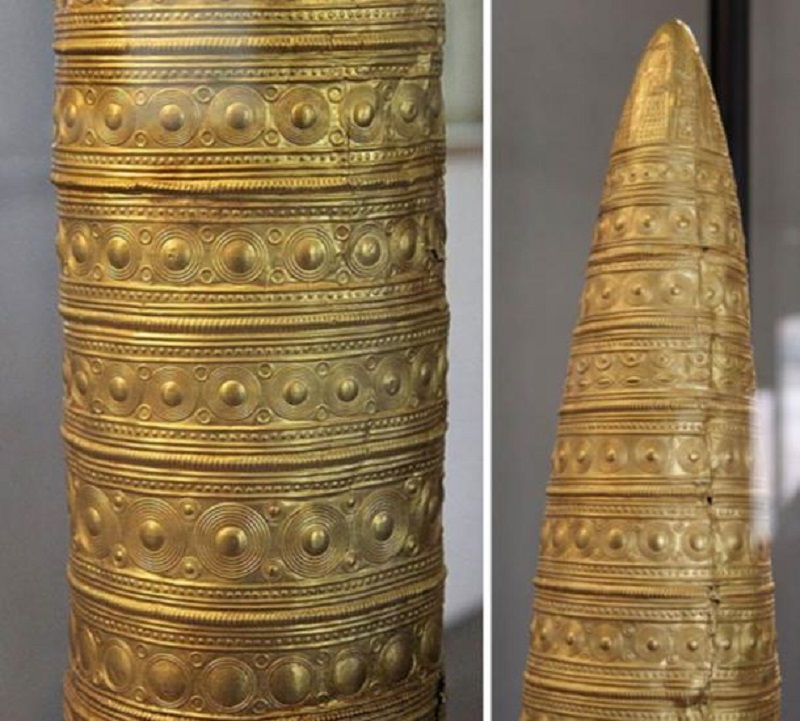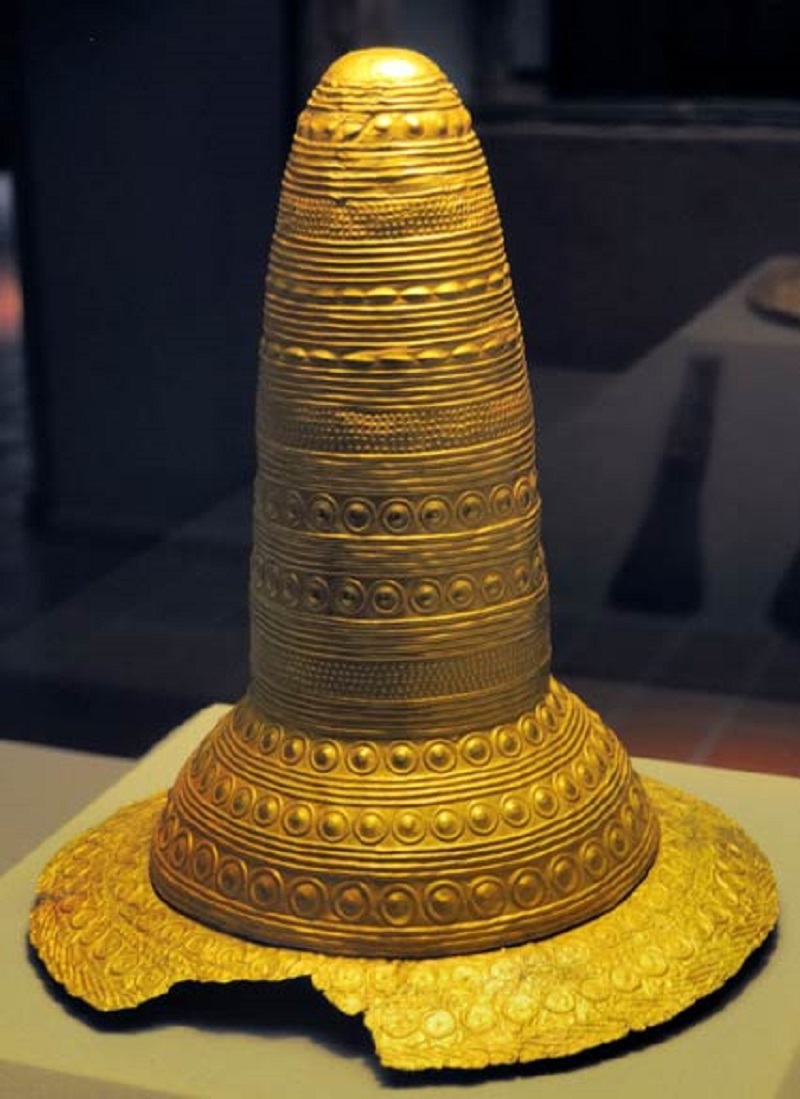Relics and artifacts discovered throughout the centuries have provided an extensive knowledge base about how our ancient ancestors lived, what they believed, and what skills they possessed. Every once in a while, a startling discovery challenges our understanding of ancient societies and cultures, while also providing surprising new information about past civilizations. One such find is the discovery of four cone-shaped golden helmets from the Bronze Age.
Discovered in different locations and times, the four golden hats have many similarities in size, shape, design and structure. Their conical design mimics the famous image of a witch or wizard’s hat, leading to speculation that these hats were worn by individuals holding such positions. Hats inscribed with symbols may have been used to make agricultural and/or astronomical predictions, possibly elevating the wearer to divine status.

Four golden hats. From left to right: Vienne, France (1844); Southern Germany or Switzerland (1996); Schifferstadt, Germany (1835); Ezelsdorf, Germany (1953). Public domain
The four golden hats are rare archaeological finds dating back to the Bronze Age, existing from 3300 – 700 BC. All the hats appear to have been created around the middle of this period, from 1400 to 800 BC. They were discovered separately over the course of 160 years in different locations, three of which were in Germany and one in France. Of course, it’s likely that more golden hats will be discovered in the future.
The gold relics are made from gold sheets, with intricate astronomical designs and show great craftsmanship. Although the four hats have striking similarities, they are also somewhat unique in their specific characteristics.
The first hat was discovered in 1835 in Schifferstadt, Germany. It is called Schifferstadt’s Golden Hat. Schifferstadt’s golden hat was discovered by a farmer and appears to have been intentionally buried. It is the shortest of the four hats, measuring 29.6 cm tall. It is divided into strips running the length of the hat, with each strip decorated with one of a number of designs including circles, discs and eye-like shapes. Schifferstadt’s Golden Helmet is believed to have been made around 1400–1300 BC.
Schifferstadt’s Golden Hat (Wikimedia Commons)
The second hat discovered was the Avanton Gold Cone, discovered in Avanton, France in 1844. The Avanton hat is believed to have been created between 1000-900 BC and is the only one Missing rim once. However, signs of damage indicate that the Avanton hat once had a brim. The cone stands at 55 cm. The Avanton hat also has a ribbon with repeating circular symbols.

Avanton Yellow Hat (Wikimedia Commons)
The third hat discovered is the Golden Hat of Ezelsdorf-Buch, discovered near Ezelsdorf, Germany in 1953. The Golden Hat of Ezelsdorf-Buck is the tallest of the four hats, 88 cm tall and has a Same strip design with repeating borders. circles, discs and eye-like shapes. It is believed to have originated between 1000-900 BC.

Close-up of Ezelsdorf-Buch’s Golden Helmet, showing the intricate designs carved into the gold plate (Wikimedia Commons)
The origin of the fourth yellow hat is unclear but is believed to have been found in southern Germany or Switzerland – it was noticed in the international art trade in 1995. The hat originated in 1000-800 BC and was called Berlin. Yellow Hat because it was acquired by the Berlin Museum. It is 75 cm tall, has the same striped pattern as the others.

Details about the Berlin Yellow Helmet (Wikimedia Commons)
The purpose of the yellow hats is unknown. Although they are found in different regions, speculations have grown around the hats as a group, with the assumption that they were all used for similar purposes. For a time, hats were thought to be symbols of fertility, perhaps due to their phallic shape. Researchers once believed that these helmets were part of ancient armor or that they were used as ceremonial vases. These hats are then said to have been placed on stakes at places of worship as decorative headdresses. It is also speculated that the four hats once belonged to ancient witches, due to their resemblance to witch-style hats.
More recently, German archaeologists and historians believe that these helmets were, in fact, used by individuals considered ‘witches’ during the Bronze Age. According to these recent theories, astrological symbols were used to track the stars and sun, allowing for agricultural predictions, specifically when to plant and harvest. Those who wear hats are called “king-priests”. Because they have the ability to predict and are therefore believed to have supernatural powers. While predicting time and weather is common today due to modern knowledge and technology, the ability to predict climatic conditions during the Bronze Age was considered a divine power.
Wilfried Menghin, director of the Berlin Museum, has carefully studied the hats. According to Menghin, the priest-kings “can be thought of as Time Lords, people with access to divine knowledge that helps them see into the future.” According to Menghin, the sun and moon symbols are suitable for “Metonic”. Cycle”, which provides an explanation of the temporal relationship between the sun and the moon. The knowledge this model provides will enable long-term predictions of the solar and lunar cycles. Overall, this This shows that the people who lived in Europe during the Bronze Age were much more complex than we initially believed. It’s easy to see how the ability to make such long-term astrological predictions would bring giving a person the appearance of divine or magical powers since the Bronze Age. of ancient witches is not a legend or myth, but a true reflection of how the wearer was perceived it thanks to their ability to predict time.
The discovery of four golden hats has provided fascinating insight into the lives and customs of people who lived some three millennia ago. The use of hats to predict the movement of the sun and the temporal relationship between the sun and the moon is not entirely novel, as many ancient artifacts show a strong focus on astrological characteristics so. But why they chose to display such knowledge on golden hats is unclear. Perhaps with further research, we will one day know why Bronze Age ‘magicians’ wore these spectacular golden helmets.



